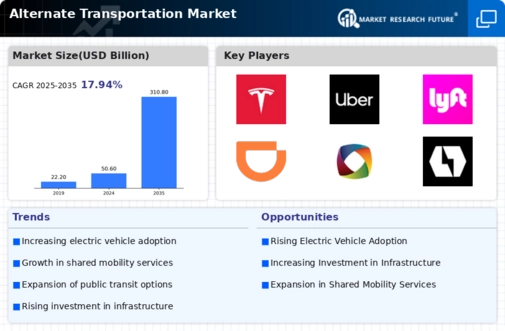Technological Advancements
Technological advancements are transforming the Alternate Transportation Market in profound ways. Innovations in battery technology, autonomous driving, and smart transportation systems are enhancing the efficiency and appeal of alternative transport options. For example, improvements in battery life and charging infrastructure are making electric vehicles more practical for everyday use. Additionally, the integration of smart technologies, such as real-time traffic management systems, is optimizing urban mobility. Market data indicates that investments in research and development within the transportation sector are on the rise, suggesting a strong commitment to advancing these technologies. As these advancements continue to unfold, they are likely to attract more consumers to the Alternate Transportation Market, thereby fostering a more sustainable transportation ecosystem.
Consumer Demand for Convenience
Consumer demand for convenience is emerging as a key driver in the Alternate Transportation Market. As lifestyles evolve, individuals increasingly seek transportation options that offer flexibility and ease of use. The rise of shared mobility services, such as ride-hailing and bike-sharing, reflects this shift in consumer preferences. Market data suggests that these services are gaining traction, particularly in urban areas where traditional transportation options may be less accessible. The convenience of on-demand transportation solutions is likely to attract a broader audience to the Alternate Transportation Market. As companies innovate to meet these demands, the market is expected to expand, offering a diverse range of options that cater to the evolving needs of consumers.
Increasing Environmental Awareness
The rising consciousness regarding environmental issues appears to be a pivotal driver for the Alternate Transportation Market. As individuals and organizations become more aware of the detrimental effects of traditional transportation methods on the environment, there is a noticeable shift towards sustainable alternatives. This trend is evidenced by a significant increase in the adoption of electric vehicles and other eco-friendly transport options. According to recent data, the demand for electric vehicles has surged, with projections indicating that they could account for a substantial percentage of new vehicle sales in the coming years. This heightened environmental awareness is likely to propel innovations and investments in the Alternate Transportation Market, as stakeholders seek to align with consumer preferences for greener solutions.
Urbanization and Population Growth
Urbanization and population growth are significant factors influencing the Alternate Transportation Market. As urban areas expand and populations increase, the demand for efficient and sustainable transportation solutions becomes more pressing. Cities are grappling with congestion and pollution, prompting a shift towards alternative modes of transport such as public transit, cycling, and electric scooters. Data indicates that urban areas with high population densities are more likely to invest in alternative transportation infrastructure, thereby enhancing accessibility and reducing reliance on personal vehicles. This trend is expected to continue, as urban planners and policymakers recognize the need for sustainable solutions to accommodate growing populations. Consequently, the Alternate Transportation Market is poised for growth as cities adapt to these demographic changes.
Government Initiatives and Policies
Government initiatives and policies play a crucial role in shaping the landscape of the Alternate Transportation Market. Various governments are implementing regulations and incentives aimed at reducing carbon emissions and promoting sustainable transportation. For instance, tax credits for electric vehicle purchases and investments in public transportation infrastructure are becoming increasingly common. Data suggests that countries with robust policies supporting alternative transportation options have witnessed a marked increase in their adoption rates. These initiatives not only encourage consumers to opt for greener choices but also stimulate the development of new technologies within the Alternate Transportation Market. As governments continue to prioritize sustainability, the market is expected to experience further growth driven by supportive legislative frameworks.

















